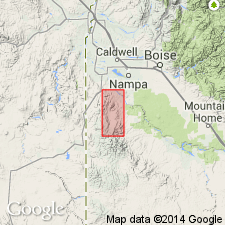
- Usage in publication:
-
- Boston Ranch Formation, unit
- Modifications:
-
- Named
- Dominant lithology:
-
- Tuff
- Diatomite
- Pumice
- Breccia
- Lignite
- AAPG geologic province:
-
- Snake River basin
Summary:
Named; type locality designated on conical hill on the Boston Ranch (for which unit is named) immediately north of Farrot Creek, on border between secs 10 and 11, T2S, R4W, Owyhee Co, ID, Snake River basin. Is formation and one of eight units of Reynolds Basin Group (new), which is of late Miocene or early Pliocene age. Occupies an outcrop belt 1 mi wide, extending southward through Salmon Creek Valley and along west margin of Reynolds Basin; terminates near south end of basin. Belt is bordered on east by arkosic unit in Reynolds Basin, and by Hoot Nanny or Soldier Cap Olivine Basalts (both new) along east side of Salmon Creek Valley. The lower latite unit and older rocks bound Boston Ranch on west--all are part of Reynolds Basin Group. Consists of yellow-gray, altered, fine vitric tuff; pure and tuffaceous diatomite, (usually pale orange when fresh); pumicite, light gray when fresh, yellow gray when weathered; pumice breccia, light gray to brown; and lignite. Detritus derived from granitic or basaltic terranes present locally, but is subordinate. Very weakly resistant to weathering and erosion; no continuous outcrops. Strong white soil tones visible on aerial photographs. Maximum thickness measured at an outcrop is 208 ft. Thickness of 460 ft derived by seismic survey from one locality. Thickness of about 800 ft obtained by projecting basal contacts beneath Salmon Creek Valley.
Source: GNU records (USGS DDS-6; Denver GNULEX).
For more information, please contact Nancy Stamm, Geologic Names Committee Secretary.
Asterisk (*) indicates published by U.S. Geological Survey authors.
"No current usage" (†) implies that a name has been abandoned or has fallen into disuse. Former usage and, if known, replacement name given in parentheses ( ).
Slash (/) indicates name conflicts with nomenclatural guidelines (CSN, 1933; ACSN, 1961, 1970; NACSN, 1983, 2005, 2021). May be explained within brackets ([ ]).

